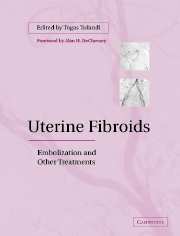Book contents
- Frontmatter
- Contents
- Contributors
- Preface
- Foreword
- 1 Uterine fibroids: epidemiology and an overview
- 2 Histopathology of uterine leiomyomas
- 3 Imaging of uterine leiomyomas
- 4 Abdominal myomectomy
- 5 Laparoscopic managment of uterine myoma
- 6 Hysteroscopic myomectomy
- 7 Myomas in pregnancy
- 8 Expectant and medical management of uterine fibroids
- 9 Hysterectomy for uterine fibroid
- 10 History of embolization of uterine myoma
- 11 Uterine artery embolization – vascular anatomic considerations and procedure techniques
- 12 Pain management during and after uterine artery embolization
- 13 Patient selection, indications and contraindications
- 14 Results of uterine artery embolization
- 15 Side effects and complications of embolization
- 16 Reproductive function after uterine artery embolization
- 17 Reasons and prevention of embolization failure
- 18 Future of embolization and other therapies from gynecologic perspectives
- 19 The future of fibroid embolotherapy: a radiological perspective
- Index
- Plate section
8 - Expectant and medical management of uterine fibroids
Published online by Cambridge University Press: 10 November 2010
- Frontmatter
- Contents
- Contributors
- Preface
- Foreword
- 1 Uterine fibroids: epidemiology and an overview
- 2 Histopathology of uterine leiomyomas
- 3 Imaging of uterine leiomyomas
- 4 Abdominal myomectomy
- 5 Laparoscopic managment of uterine myoma
- 6 Hysteroscopic myomectomy
- 7 Myomas in pregnancy
- 8 Expectant and medical management of uterine fibroids
- 9 Hysterectomy for uterine fibroid
- 10 History of embolization of uterine myoma
- 11 Uterine artery embolization – vascular anatomic considerations and procedure techniques
- 12 Pain management during and after uterine artery embolization
- 13 Patient selection, indications and contraindications
- 14 Results of uterine artery embolization
- 15 Side effects and complications of embolization
- 16 Reproductive function after uterine artery embolization
- 17 Reasons and prevention of embolization failure
- 18 Future of embolization and other therapies from gynecologic perspectives
- 19 The future of fibroid embolotherapy: a radiological perspective
- Index
- Plate section
Summary
Expectant Management
The decision to treat a patient with an enlarged and symptomatic uterine fibroid is typically straightforward. However, the best approach in asymptomatic women with an enlarged uterus is not always clear. Uterine leiomyomata occur in the vast majority of women, but the total prevalence is unknown. Of the total 600 000 hysterectomies performed each year, 20–30% are due to uterine fibroids and some of these hysterectomies are done merely due to an enlarged uterus.
The initial diagnostic dilemma for the clinician when a patient presents with a large pelvic mass is to determine its origin. The reasons many gynecologists have not pursued expectant treatment and the rationale of this type of management will be discussed in this review.
Predictable growth of uterine fibroids
There are no data to support the concept that myomas will continue to grow. It is known, however, that fibroids will shrink after menopause. This is due to the decline in endogenous estrogen levels. Racial differences, body mass index (BMI) and parity are factors that affect the risk of developing clinically significant leiomyomas. Nevertheless, good information on the natural history of the disease is lacking. One recent report suggests that some small myomas, if simply observed, will regress.
Missed or delayed diagnosis of uterine sarcoma
The size of the uterus poorly predicts the likelihood of malignancy. In a retrospective study, 1332 women with enlarged uterine myoma were surgically treated.
- Type
- Chapter
- Information
- Uterine FibroidsEmbolization and other Treatments, pp. 65 - 73Publisher: Cambridge University PressPrint publication year: 2003

